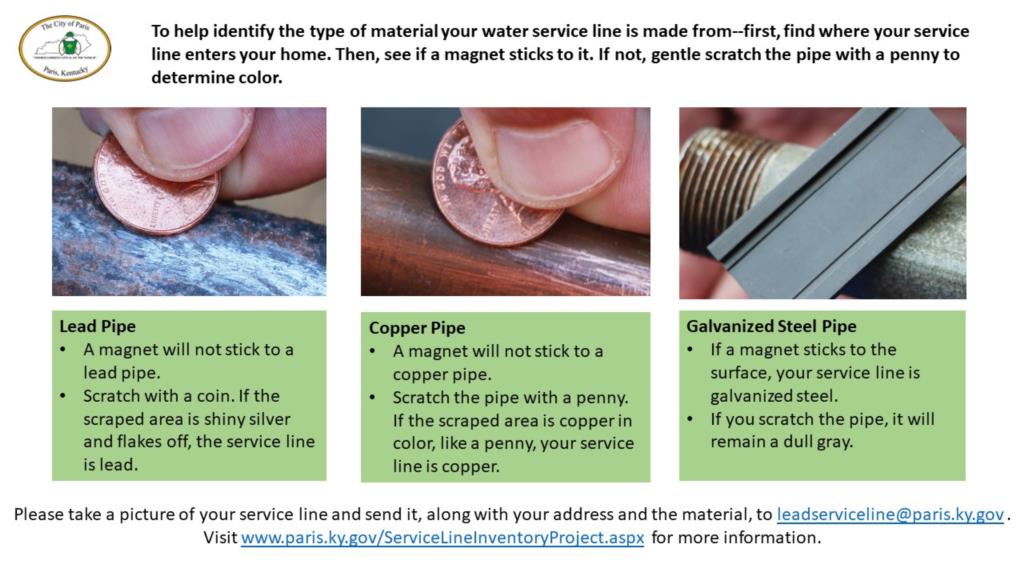Service Line Inventory Project – Lead and Drinking Water
Public health is our number one priority, and your drinking
water meets all Environmental Protection Agency’s (EPA) strict health
standards. Paris Combined Utilities water is safe, high-quality, and does not
contain lead when it leaves the treatment plant. However, if there are lead
pipes on your property, there is a risk of lead entering the drinking water.
Household plumbing used lead piping well
into the 1980s, until it was banned by Congress in 1986. Lead can be present in
some pipes that connect older homes to the public water system, as well as
within the home’s plumbing.
Due to Federal Regulations, the City of Paris is conducting an inventory
of all service lines that are in and touching the system. An update to the
EPA’s guidelines requires all water providers in the US to complete this
inventory.
The City needs your help. The best way to complete this inventory is for each
resident and homeowner to identify the material of their service line. If you
are able, please take a picture and email your address and the material
to leadserviceline@paris.ky.gov.
Your line may be made of plastic. It also may be made of lead, copper, or
galvanized steel. Below are some graphics to help you identify your service
line material:


Below are some Frequently Asked Questions on the Service Line
Inventory Project
What is lead?
Lead is a naturally occurring metal that may be harmful if inhaled or
swallowed. Lead does not naturally occur in water, but may be leached into
water from plumbing fixtures, lead based solder, and service lines.
What is a Service Line?
The pipe that connects your household plumbing to the water main in the
street is called a Service Line. Service Lines past the water meter are not
part of the public water system and are the responsibility of the property
owner.

What does a Lead Service Line Look Like?

Lead service lines are generally a dull gray color and are soft. You can
identify them easily by carefully scratching with a key. If the pipe is made of
lead, the area you scratched will turn a bright silver color.
Do not use a knife or other sharp instrument and take care not to
puncture a hole in the pipe.
Note: galvanized piping can also be dull gray in color. A strong magnet
will typically cling to galvanized pipe, but will not cling to lead pipes.
The best way to know what kind of plumbing and service lines you have in
your home is to hire a licensed plumber.
What happens if I have a lead service line?
If you have a lead service line, the City of Paris encourages you to
replace your service line. The property owner is responsible for any portion of
the service line after the meter. The actual cost of the service line
replacement depends on several factors including length of service line, where
the service line is located, and the technique used to install the service
line. Please contact a licensed plumber to discuss a lead service line
replacement. It is always a good idea to get a quote in advance of hiring a
professional plumber to do work in your home. The City of Paris cannot
recommend plumbers.
Immediately after a lead service line replacement, you will need to flush
the service line.
Does the City perform Lead Sampling?
The results from samples
collected in the water system are included in the annual water quality report
(also known as the Consumer Confidence Report). Results are available by
calling the Water Plant at 859-987-2118
Because service lines,
faucet fixtures, household pipes, and/or solder can contribute significantly to
the lead and copper levels in tap water, we ask our customers to collect
samples in their homes. These samples are collected on a tri-annual basis (by
monitoring once every three years) at homes that are considered vulnerable
based on when they were constructed, and the materials used. We do this
monitoring according to the requirements of the Lead and Copper Rule by the EPA.
Is water the only source of lead in homes and businesses?
No. Lead in drinking water generally represents only about 20% of total
exposures according to the US Center for Disease Control and Prevention.